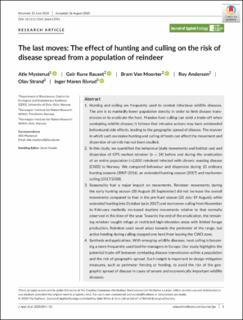| dc.description.abstract | 1. Hunting and culling are frequently used to combat infectious wildlife diseases. The aim is to markedly lower population density in order to limit disease transmission or to eradicate the host. Massive host culling can yield a trade-off when combating wildlife disease; it follows that intrusive actions may have unintended behavioural side effects, leading to the geographic spread of disease. The manner in which such excessive hunting and culling of hosts can affect the movement and dispersion of cervids has not been studied. 2. In this study, we quantified the behaviour (daily movements and habitat use) and dispersion of GPS-marked reindeer (n = 24) before and during the eradication of an entire population (>2,000 reindeer) infected with chronic wasting disease (CWD) in Norway. We compared behaviour and dispersion during 10 ordinary hunting seasons (2007–2016), an extended hunting season (2017) and marksmen culling (2017/2018). 3. Seasonality had a major impact on movements. Reindeer movements during the early hunting season (20 August–20 September) did not increase the overall movements compared to that in the pre-hunt season (20 July–19 August), while extended hunting into October (as in 2017) and marksmen culling from November to February markedly increased daytime movements relative to that normally observed in this time of the year. Towards the end of the eradication, the remaining reindeer sought refuge at restricted high-elevation areas with limited forage production. Reindeer used novel areas towards the perimeter of the range, but active herding during culling stopped one herd from leaving the CWD zone. 4. Synthesis and applications. With emerging wildlife diseases, host culling is becoming a more frequently used tool for managers in Europe. Our study highlights the potential trade-off between combating disease transmission within a population and the risk of geographic spread. Such insight is important to design mitigation measures, such as perimeter fencing or herding, to avoid the risk of the geographic spread of disease in cases of severe and economically important wildlife diseases. cervids, chronic wasting disease, disease ecology, disease management, host culling, movement ecology, spatial organization, unintended side effects | en_US |

